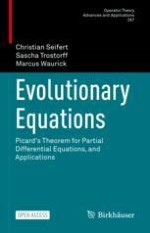Let
\(f\in \mathcal {S}(\mathbb {R};H)\). By Exercise
5.1 we have
$$\displaystyle \begin{aligned} \widehat{f}\:'(s)=\frac{1}{\sqrt{2\pi}}\int_{\mathbb{R}}(-\mathrm{i} t)\mathrm{e}^{-\mathrm{i} st}f(t)\,\mathrm{d} t=-\mathrm{i}\widehat{\big(t\mapsto tf(t)\big)}(s)\quad (s\in\mathbb{R}){} \end{aligned} $$
(5.4)
and
$$\displaystyle \begin{aligned} s\widehat{f}(s)=\frac{\mathrm{i}}{\sqrt{2\pi}}\intop_{\mathbb{R}}\left(-\mathrm{i} s\right)\mathrm{e}^{-\mathrm{i} st}f(t)\,\mathrm{d} t=-\mathrm{i}\widehat{f'}(s)\quad (s\in\mathbb{R}).{} \end{aligned} $$
(5.5)
Using these formulas, one can show that
\(\widehat {f}\in \mathcal {S}(\mathbb {R};H).\) Since the bijectivity of the Fourier transformation on
\(\mathcal {S}(\mathbb {R};H)\) would follow from (
5.3), it suffices to prove the formulas (
5.2) and (
5.3). Let
\(f,g\in L_{1}(\mathbb {R};H).\) Then we compute using Proposition
3.1.6 and Fubini’s theorem
$$\displaystyle \begin{aligned} \int_{\mathbb{R}}\left\langle \widehat{f}(t) ,g(t)\right\rangle \,\mathrm{d} t & =\int_{\mathbb{R}}\frac{1}{\sqrt{2\pi}}\left\langle \int_{\mathbb{R}}\mathrm{e}^{-\mathrm{i} st}f(s)\,\mathrm{d} s ,g(t)\right\rangle \,\mathrm{d} t\\ & =\int_{\mathbb{R}}\int_{\mathbb{R}}\frac{1}{\sqrt{2\pi}}\mathrm{e}^{\mathrm{i} st}\left\langle f(s) ,g(t)\right\rangle \,\mathrm{d} s\,\mathrm{d} t\\ & =\int_{\mathbb{R}}\left\langle f(s) ,\frac{1}{\sqrt{2\pi}}\int_{\mathbb{R}}\mathrm{e}^{\mathrm{i} st}g(t)\,\mathrm{d} t\right\rangle \,\mathrm{d} s\\ & =\int_{\mathbb{R}}\left\langle f(s) ,\widehat{g}(-s)\right\rangle \,\mathrm{d} s, \end{aligned} $$
which yields (
5.2). For proving formula (
5.3), we consider the function
γ defined by

for
\(t\in \mathbb {R}\). Clearly,
\(\gamma \in \mathcal {S}(\mathbb {R})\). We claim that
\(\widehat {\gamma }=\gamma \). Indeed, we observe that
γ solves the initial value problem
y′ +
ty = 0 subject to
y(0) = 1; if we can show that
\(\widehat {\gamma }\) solves the same initial value problem, then their equality would follow from the uniqueness of the solution. First, we observe that
\(\widehat {\gamma }(0)=\frac {1}{\sqrt {2\pi }}\int _{\mathbb {R}}\mathrm {e}^{-\frac {t^{2}}{2}}\,\mathrm {d} t=1.\) Second, we compute using the formulas (
5.4) and (
5.5) that
$$\displaystyle \begin{aligned} \widehat{\gamma}'(s)=-\mathrm{i}\widehat{\big(t\mapsto t\gamma(t)\big)}(s)=\mathrm{i}\widehat{\gamma'}(s)=-s\widehat{\gamma}(s)\quad (s\in\mathbb{R}). \end{aligned}$$
Altogether, we have shown that
\(\widehat {\gamma }\) solves the same initial value problem as
γ and hence,
\(\widehat {\gamma }=\gamma \). Let now
\(f\in L_{1}(\mathbb {R};H)\) with
\(\widehat {f}\in L_{1}(\mathbb {R};H),\)
a > 0 and
x ∈
H. Then we compute using (
5.2)
$$\displaystyle \begin{aligned} \left\langle \int_{\mathbb{R}}\widehat{f}(t)\gamma(at)\mathrm{e}^{\mathrm{i} st}\,\mathrm{d} t ,x\right\rangle & =\int_{\mathbb{R}}\left\langle \widehat{f}(t) ,\gamma(at)x\mathrm{e}^{-\mathrm{i} st}\right\rangle \,\mathrm{d} t =\int_{\mathbb{R}}\left\langle f(t) ,\widehat{\big(\gamma(a\cdot)x\mathrm{e}^{-\mathrm{i} s(\cdot)}\big)}(-t)\right\rangle \,\mathrm{d} t\\ & =\int_{\mathbb{R}}\left\langle f(t) ,\frac{1}{\sqrt{2\pi}}\int_{\mathbb{R}}\gamma(ar)x\mathrm{e}^{-\mathrm{i} sr}\mathrm{e}^{\mathrm{i} tr}\,\mathrm{d} r\right\rangle \,\mathrm{d} t\\ & =\frac{1}{a}\int_{\mathbb{R}}\left\langle f(t) ,\widehat{\gamma}\left(\frac{s-t}{a}\right)x\right\rangle \,\mathrm{d} t =\frac{1}{a}\int_{\mathbb{R}}\left\langle f(t) ,\gamma\left(\frac{s-t}{a}\right)x\right\rangle \,\mathrm{d} t\\ & =\int_{\mathbb{R}}\left\langle f(s-at) ,\gamma\left(t\right)x\right\rangle \,\mathrm{d} t =\left\langle \int_{\mathbb{R}}f(s-at)\gamma\left(t\right)\,\mathrm{d} t ,x\right\rangle \end{aligned} $$
for each
\(s\in \mathbb {R}\). Since this holds for all
x ∈
H we get
$$\displaystyle \begin{aligned} \int_{\mathbb{R}}\widehat{f}(t)\gamma(at)\mathrm{e}^{\mathrm{i} st}\,\mathrm{d} t=\int_{\mathbb{R}}f(s-at)\gamma\left(t\right)\,\mathrm{d} t\quad (s\in\mathbb{R}). \end{aligned}$$
Letting
a → 0 in the latter equality, we obtain
$$\displaystyle \begin{aligned} \int_{\mathbb{R}}\widehat{f}(t)\mathrm{e}^{\mathrm{i} st}\,\mathrm{d} t=\lim_{a\to0}\int_{\mathbb{R}}f(s-at)\gamma\left(t\right)\,\mathrm{d} t \quad (s\in\mathbb{R}),{} \end{aligned} $$
(5.6)
where we have used dominated convergence for the term on the left-hand side. In order to compute the limit on the right-hand side, we first observe that
$$\displaystyle \begin{aligned} \int_{\mathbb{R}}\left\Vert \int_{\mathbb{R}}f(s-at)\gamma\left(t\right)\,\mathrm{d} t \right\Vert \,\mathrm{d} s\leqslant\int_{\mathbb{R}}\int_{\mathbb{R}}\left\Vert f(s-at) \right\Vert \,\mathrm{d} s\:\gamma(t)\,\mathrm{d} t=\left\Vert f \right\Vert {}_{1}\left\Vert \gamma \right\Vert {}_{1}, \end{aligned}$$
and hence, for each
a > 0 the operator
$$\displaystyle \begin{aligned} S_{a}\colon L_{1}(\mathbb{R};H)& \to L_{1}(\mathbb{R};H),\\ f & \mapsto \left(s\mapsto\int_{\mathbb{R}}f(s-at)\gamma\left(t\right)\,\mathrm{d} t\right) \end{aligned} $$
is bounded by
\(\left \Vert \gamma \right \Vert { }_{1}\). Moreover, since
\(S_{a}\psi \to \psi (\cdot )\left \Vert \gamma \right \Vert { }_{1}\) as
a → 0 for
\(\psi \in C_{\mathrm {c}}(\mathbb {R};H)\), we infer that
$$\displaystyle \begin{aligned} S_{a}f\to f(\cdot)\left\Vert \gamma \right\Vert {}_{1}\quad (a\to0) \end{aligned}$$
for each
\(f\in L_{1}(\mathbb {R};H)\). Hence, passing to a suitable sequence
\(\left (a_{n}\right )_{n}\) in
\(\mathbb {R}_{>0}\) tending to 0, we get
$$\displaystyle \begin{aligned} \lim_{n\to\infty}\left(S_{a_{n}}f\right)(s)\to f(s)\left\Vert \gamma \right\Vert {}_{1}\quad (\text{a.e. } s\in\mathbb{R}). \end{aligned}$$
Using this identity for the right-hand side of (
5.6), we get
$$\displaystyle \begin{aligned} \int_{\mathbb{R}}\widehat{f}(t)\mathrm{e}^{\mathrm{i} st}\,\mathrm{d} t=f(s)\left\Vert \gamma \right\Vert {}_{1}\quad (\text{a.e. } s\in\mathbb{R}), \end{aligned}$$
and since
\(\left \Vert \gamma \right \Vert { }_{1}=\sqrt {2\pi }\), we derive (
5.3). □



 .
. for \(t\in \mathbb {R}\). Clearly, \(\gamma \in \mathcal {S}(\mathbb {R})\). We claim that \(\widehat {\gamma }=\gamma \). Indeed, we observe that γ solves the initial value problem y′ + ty = 0 subject to y(0) = 1; if we can show that \(\widehat {\gamma }\) solves the same initial value problem, then their equality would follow from the uniqueness of the solution. First, we observe that \(\widehat {\gamma }(0)=\frac {1}{\sqrt {2\pi }}\int _{\mathbb {R}}\mathrm {e}^{-\frac {t^{2}}{2}}\,\mathrm {d} t=1.\) Second, we compute using the formulas (5.4) and (5.5) that
for \(t\in \mathbb {R}\). Clearly, \(\gamma \in \mathcal {S}(\mathbb {R})\). We claim that \(\widehat {\gamma }=\gamma \). Indeed, we observe that γ solves the initial value problem y′ + ty = 0 subject to y(0) = 1; if we can show that \(\widehat {\gamma }\) solves the same initial value problem, then their equality would follow from the uniqueness of the solution. First, we observe that \(\widehat {\gamma }(0)=\frac {1}{\sqrt {2\pi }}\int _{\mathbb {R}}\mathrm {e}^{-\frac {t^{2}}{2}}\,\mathrm {d} t=1.\) Second, we compute using the formulas (5.4) and (5.5) that
















 . Let
\(g\colon \overline {U}\to H\)
be continuous and holomorphic on U such that
\(g(\mathrm {i}\cdot +\nu ),g(\mathrm {i}\cdot +\mu )\in L_2(\mathbb {R};H)\)
and there exists a sequence
\((R_{n})_{n\in \mathbb {N}}\)
in
\(\mathbb {R}_{\geqslant 0}\)
such that R
n →∞ and
. Let
\(g\colon \overline {U}\to H\)
be continuous and holomorphic on U such that
\(g(\mathrm {i}\cdot +\nu ),g(\mathrm {i}\cdot +\mu )\in L_2(\mathbb {R};H)\)
and there exists a sequence
\((R_{n})_{n\in \mathbb {N}}\)
in
\(\mathbb {R}_{\geqslant 0}\)
such that R
n →∞ and

 with a < b and x ∈ H first. For \(\rho \in \mathbb {R}\) we compute
with a < b and x ∈ H first. For \(\rho \in \mathbb {R}\) we compute

 for \(t\in \mathbb {R}.\) Show that \(g_{\alpha }\in L_{1,\nu }(\mathbb {R})\) for each ν > 0 and that
for \(t\in \mathbb {R}.\) Show that \(g_{\alpha }\in L_{1,\nu }(\mathbb {R})\) for each ν > 0 and that
 . Show that \(f\in \bigcap _{\mu <\rho <\nu }L_{2,\rho }(\mathbb {R};H)\cap L_{1,\rho }(\mathbb {R};H)\) and that
. Show that \(f\in \bigcap _{\mu <\rho <\nu }L_{2,\rho }(\mathbb {R};H)\cap L_{1,\rho }(\mathbb {R};H)\) and that
